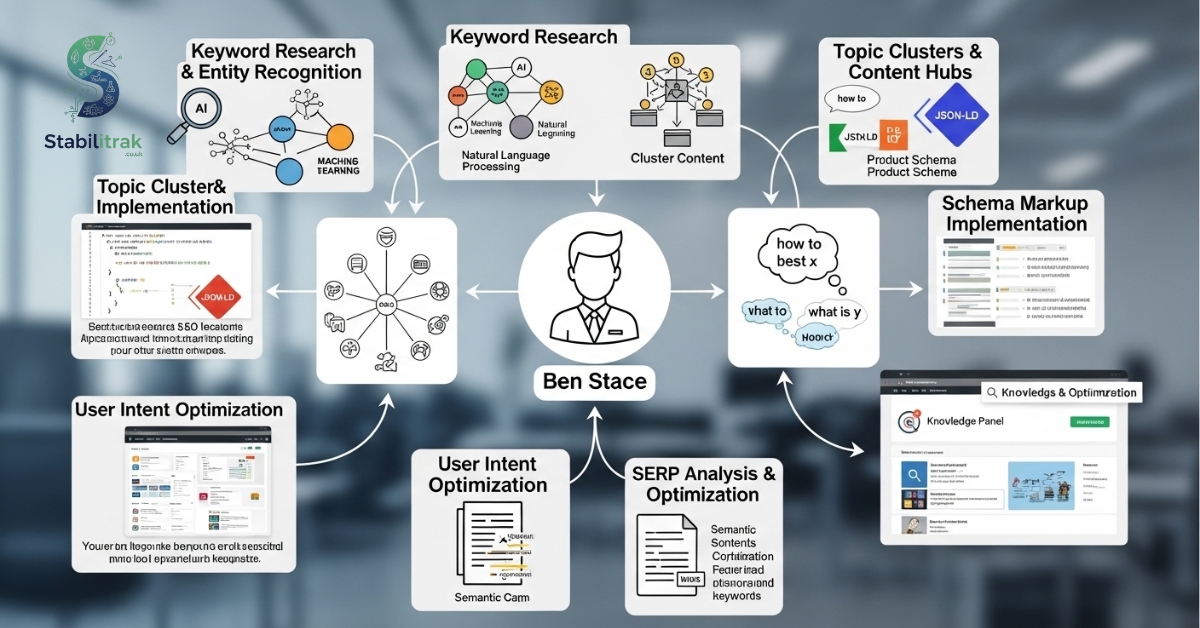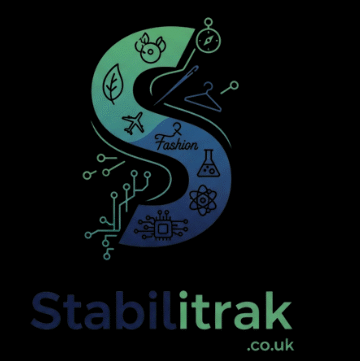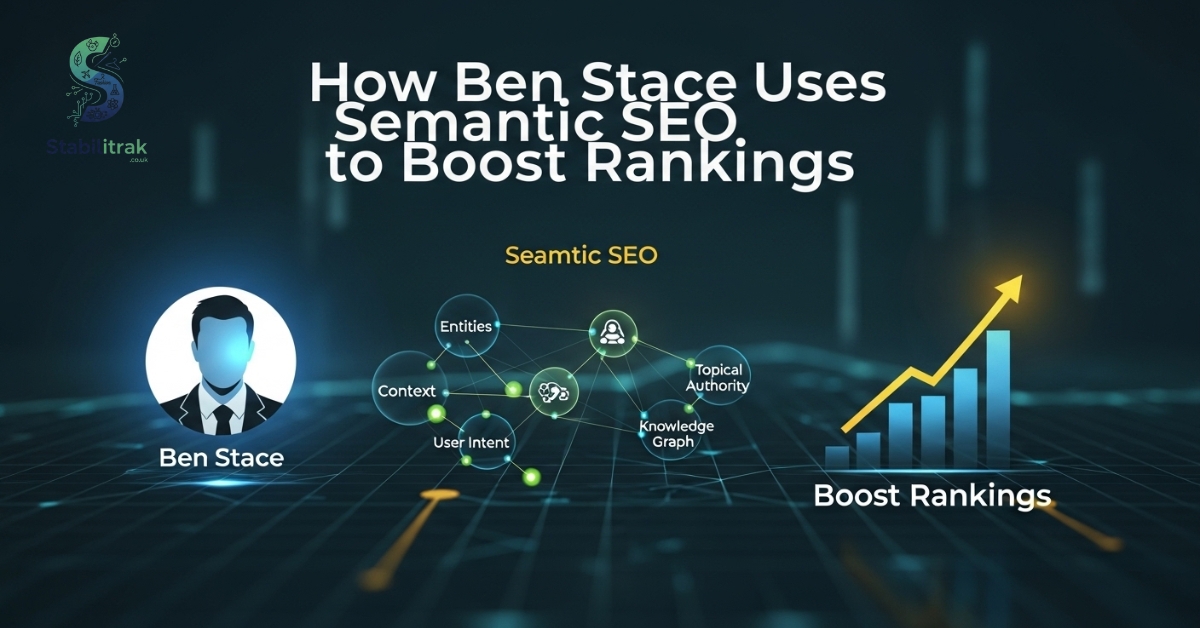Ever feel like you’ve done everything right with SEO stuffed in the keywords, built a few backlinks, even written long posts, yet your content still doesn’t rank the way you hoped? You’re not alone. The truth is, Google has become much smarter, and old tricks don’t work anymore. That’s why so many people are now asking about semantic SEO, because it promises to solve the ranking puzzle in a way that actually makes sense.
In this blog, we’ll break down what semantic SEO really means and why it’s a game-changer for anyone serious about showing up in search results. You’ll see how it goes beyond keywords, taps into search intent, and helps you create content that both readers and search engines love. By the end, you’ll know exactly how to use semantic SEO to give your content the boost it’s been missing.
Who is Ben Stace?
Ben Stace is an SEO consultant known for his work on semantic SEO strategies. He helps businesses, from local contractors to enterprise companies, improve search visibility using entity-based optimization, topical mapping, and structured content.
Through his agency VConekt, Ben developed tools that integrate with Google Docs and WordPress to guide writers in building semantic-rich content. His approach isn’t about chasing keywords but about mapping how people search, what Google’s knowledge graph understands, and how content can align with that.
How Does Ben Stace Do Semantic SEO?

Ben Stace’s method combines topic research, entity mapping, content clusters, and schema markup. He doesn’t rely on old-school keyword density alone. Instead, he creates a topical map, interlinks content for context, and keeps it updated with fresh insights.
This step-by-step system builds topical authority, which search engines reward with higher rankings. Let’s break down his process.
1. Starts with Topic and Entity Research
The foundation of Ben’s process is deep research. He identifies not just keywords but entities, people, places, tools, and concepts that form the backbone of a topic. For example, in an article about local SEO, entities might include “Google Business Profile,” “map pack,” and “schema markup.”
He uses tools like Answer the Public, Ahrefs, and LSI Graph to uncover long-tail keywords and semantic relationships. By mapping entities to user intent, he creates content that search engines can connect to their knowledge graph.
Builds Topical Maps and Content Clusters
Think of a topical map as a city map: the pillar page is downtown, while the cluster articles are neighborhoods connected by roads (internal links). Ben designs pillar content that explains the main idea, then links to cluster content that dives into subtopics.
This cluster approach signals topical authority. For example, a pillar page on “Semantic SEO” might connect to articles about schema markup, featured snippets, and user intent. By linking everything logically, he improves crawl depth and helps Google see the site as a knowledge hub.
Focuses on User Intent and Search Behavior
Every piece of content answers a type of query: informational, navigational, or transactional. Ben tailors content accordingly. Informational queries may need how-to guides, navigational ones may need brand comparisons, and transactional ones may need service pages.
He studies search behavior, using tools like Google Search Console and SEMrush, to align content with what people are really searching for. This ensures the content solves problems, not just ranks.
Uses Semantic Keywords & Natural Language
Instead of repeating one phrase, Ben blends in synonyms, related entities, and long-tail variations. For instance, alongside semantic seo, he’ll use terms like “semantic search,” “topical relevance,” and “contextual keywords.”
This natural use of language mirrors how people speak and search. It also helps Google’s NLP models recognize content as more complete.
Targets ‘People Also Ask’ (PAA) and Featured Snippets
You’ve probably seen the “People Also Ask” boxes in Google. Ben designs content to directly answer these micro-questions. Short, clear paragraphs and structured headings often land in featured snippets.
For example, answering “What is a topical map?” in 40 words increases the chance of being pulled into SERPs. This technique drives organic traffic and builds authority.
Adds Schema Markup to Help Search Engines
Schema markup is like a translator for search engines. By adding FAQ schema, HowTo schema, or Article schema, Ben ensures Google understands exactly what a page is about.
This structured data can improve visibility in rich results, increase click-through rates, and support voice search. In practice, it’s a simple step that adds major semantic value.
Smart Internal Linking Based on Context
Instead of random linking, Ben builds contextual connections. For example, a blog on “Featured Snippets” links to the “Semantic SEO” pillar page with anchor text like “semantic search optimization.”
This helps users navigate while signaling semantic relationships to search engines. Internal linking also spreads authority across a site, making weaker pages stronger.
Keeps Content Updated and Aligned with Trends
Google values freshness. Ben revisits content regularly to update statistics, examples, and references to new algorithms like Google MUM.
By keeping content aligned with current search trends, he avoids the “legacy content” problem where older pages lose relevance. This also signals ongoing topical authority.
Read More Article: How Much to Tint Car Windows
Why Ben’s Semantic SEO Approach Works

Search engines reward relevance, not repetition. By combining topical maps, schema, and entity optimization, Ben creates content ecosystems that outperform keyword-focused pages.
Businesses using this method often see lower bounce rates, higher engagement, and stronger rankings for long-tail searches. In other words, semantic SEO isn’t just a theory; it drives real results.
Advanced Keyword Research for Semantic SEO
Ben goes beyond keyword volume. He looks at keyword gaps, related entities, and search intent. For instance, instead of only targeting “best SEO tools,” he might also optimize for “SEO strategist,” “semantic indexing,” and “content audits.”
This creates depth and gives users multiple entry points to discover content. It also helps cover the full scope of a topic, boosting topical authority.
Leveraging Advanced Semantic SEO Tools
To scale this process, Ben uses tools like WordLift, Surfer SEO, and InLinks. These tools analyze semantic relationships, suggest entities, and score content for topical depth.
Combined with Google’s Natural Language API, they help writers craft content that’s both user-friendly and search-engine-friendly.
Read More Article: How Many Units of Botox for Forehead?
Final Thoughts: What You Can Learn from Ben Stace

Ben Stace’s approach to semantic seo shows that success isn’t about cramming in keywords; it’s about building meaning, context, and authority.
If you’re creating content, start by researching entities, building topical maps, and aligning with user intent. Add schema markup, link smartly, and keep updating your content. Over time, you’ll see better visibility, more organic traffic, and stronger brand authority.
FAQs
1. What exactly is the Ben Stace Semantic SEO Writing Tool?
It’s a content optimization tool that uses semantic SEO techniques to improve search visibility, relevance, and user engagement.
2. How does this tool function in optimizing content?
The tool analyzes keywords, entities, and context, then provides suggestions to make your content align better with search intent.
3. Is the Ben Stace tool beginner-friendly?
Yes, it’s designed with an easy-to-use interface, making it suitable for both beginners and advanced SEO professionals.
4. Can this tool actually boost my search engine rankings?
By focusing on semantic optimization and user intent, you increase your chances of ranking higher in SERPs.
5. Does it provide smart keyword suggestions for better optimization?
Yes, it offers keyword and topic suggestions based on semantic relevance, helping you cover content gaps.
6. What are semantic keywords, and why should I use them?
Semantic keywords are context-related terms that help search engines understand meaning. Using them improves relevance and topical authority.
7. Can the tool generate topic ideas related to my niche?
Absolutely. It suggests related topics and subtopics to strengthen your content clusters and authority.
8. How does it enhance content readability and flow?
It recommends structural improvements, readability fixes, and natural keyword placement for smoother content flow.
9. Does the tool allow me to run SEO checks on existing content?
Yes, it audits your current content and highlights areas for semantic and technical improvements.
10. Is it designed to work seamlessly with WordPress?
Yes, the tool integrates with WordPress, making optimization part of your publishing workflow.
11. Does the tool support multiple language options?
It supports several languages, allowing global content optimization beyond English.
12. In what ways does it improve content relevance for search engines?
By mapping entities, intent, and context, it ensure your content matches what search engines look for.
13. Is the tool suitable for optimizing long-form articles?
Yes, it’s built for both short and long-form content, helping cover depth and topical authority.
14. Can it help me target and win featured snippets on Google?
Yes, it suggests structured formatting and semantic improvements to increase snippet chances.
15. Does the tool include competitor content analysis features?
Yes, it can analyze competitor pages and highlight gaps you can fill with semantic-rich content.
16. Can I monitor my content’s SEO performance using this tool?
Yes, it tracks performance metrics, showing rankings, engagement, and improvements over time.
17. Does it offer recommendations for structuring blog posts or pages?
Yes, it provides content outlines, H2/H3 suggestions, and internal linking opportunities.
18. How can I fit the tool into my current writing workflow?
It integrates with Google Docs, WordPress, and SEO dashboards, making it easy to use daily.
19. Will using the tool increase my content’s click-through rates?
Yes, by improving relevance, readability, and meta-structure, it can boost CTR in search results.
20. What are the biggest advantages of the Ben Stace Semantic SEO Writing Tool?
Its main benefits are better topical coverage, higher rankings, and improved audience engagement.
21. How does semantic SEO work?
Semantic SEO works by optimizing content for meaning, context, and intent instead of just keywords.
22. What is an example of a semantic topic in SEO?
For “apple,” semantic SEO recognizes whether you mean the fruit or Apple Inc., based on context.
23. What is the difference between SEO and semantic SEO?
Traditional SEO focuses on keywords, while semantic SEO focuses on meaning, entities, and user intent.
24. What is the difference between semantic SEO and holistic SEO?
Semantic SEO targets context and intent, while holistic SEO takes a broader approach, including UX, design, and technical SEO.


3 thoughts on “How Ben Stace Uses Semantic SEO to Boost Rankings”